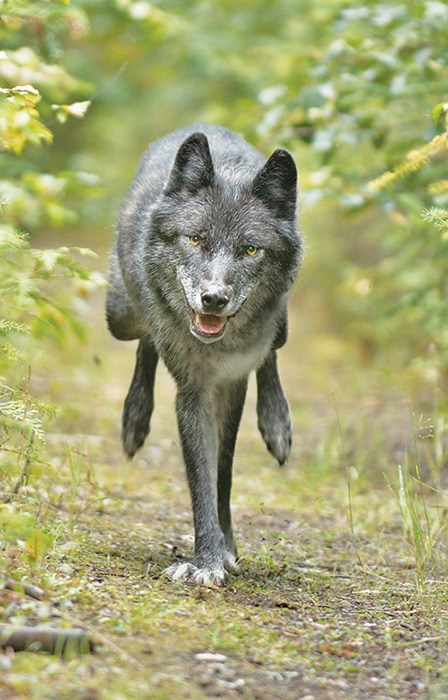The provincial Ministry of Forests, Lands and Natural Resource Operations released its new wolf management plan late last week, in which the government commits to helping ranchers and other stakeholders manage wolf populations in areas in which livestock and wildlife are threatened by wolf predation.
The plan comes as welcome news to valley ranchers who have suffered growing losses of cattle to wolves, but left wolf advocates disappointed.
“It’s a problem I’ve had for the last two years,” said local rancher Brian McKersie, who has lost 50 calves (out of a total herd of 350 cows) to wolves the past two years on his Columbia Lake ranch and crown range extending from Findlay Creek to Dutch Creek. Each calf is worth about $750, according to Mr. McKersie.
“The other part of the equation is the harassment, stress and weight loss the wolves put on the herd, which can double the dollar-value lost,” he said, adding the problem has slowly increased during the course of the past decade, but has become really pronounced the past two years.
“We’re also seeing a major impact (from wolves) on our local elk population,” said Mr. McKersie.
Wolf populations in the Kootenay region appear to be increasing, according to a ministry press relase on the new management plan. The release also said wolf populations are rising in the Cariboo, Thompson and Okanagan regions, but are stable elsewhere across the province.
Local hunters in the Upper Columbia Valley agree that, from what they’ve seen, the wolf numbers here are increasing.
“The wolf population’s gone way up; you go out on any of the backroads and you’ll see a lot more signs of them than you have before,” said local hunter Bob Walker. “We’re in favour of some form of predator control.”
Even if wolves numbers were high in the past, they were not a nuisance to ranchers as much because they would prey mainly on deer, elk and moose, but as numbers of those prey species have plummeted in recent years (with the elk population in the valley dropping from around 20,000 to fewer than 10,000, for instance), that has changed, according to Mr. Walker.
The ministry said in the plan that the current wolf population across the province is about 8,500, slightly up from an estimated 1991 population of 8,100, meaning that wolves are not considered an “at-risk” species. The plan will divide B.C. into two zones — in one zone wolves will be managed to ensure their continued ecological role and there will be sustainable hunting during a specified season, while in the other zone (the areas with livestock or other wildlife depredation by wolves) the ministry will develop implementation plans to manage the impacts of expanding wolf populations.
Public consultation on the plan resulted in the ministry receiving more than 2,500 comments, which it said were carefully reviewed and helped inform and improve the final plan.
Several East Kootenay wolf advocates felt that public input had not resulted in any substantial changes.
“The new plan has not really changed anything. It pays lip service to some of the concerns raised in the comments, but when you read through the lines, there is nothing in there about conservation of wolves, it’s all about managing wolves for the benefit of people,” said Golden-based Wolf Awareness Inc. executive director Sadie Parr.
“There’s major uncertainty about population levels and harvest rates of wolves, because there’s not mandatory reporting of killing wolves. They are using a figure of 8,500, but if look more closely you’ll see the population range is 5,300 to 11,600 and they’re just picking the number in the middle.”
The province’s last carnivore review process was in 2007, which is not recent enough, said Ms. Parr, who notes that in the past 50 years people have become accustomed to artificially low numbers of wolves as result of bounty hunting up until the 1950s, and that as wolf number rebound to previous natural levels, ranchers need to stop just simply letting their livestock roam untended and should revert to having herders, shepherds, range riders, livestock guard dogs and using night penning.
“The reality is you’ve got to put this into larger perspective. That rancher (Mr. McKersie) lost 50 wolves, but larger scale, province-wide only three per cent of livestock is lost to wolves. Unfortunately this three per cent figure often translates to one or two individuals getting hit particularly hard and these are the voices that generally get heard on the issue, but that’s not the norm for most ranchers,” said Ms. Parr. Ms. Parr has created a ranchers’ toolkit, basically a guide to promoting co-existence between people, wolves and livestock.
The province’s last wolf management plan came out in 1979.
To learn more about the new management plan, check out:
http://www.env.gov.bc.ca/fw/wildlife/management-issues/docs/grey_wolf_management_plan.pdf.
To see Ms. Parr’s ranchers’ toolkit, see:
http://media.wix.com/ugd/a966c3_06d24c4035a436a349801dc63455a905.pdf.
